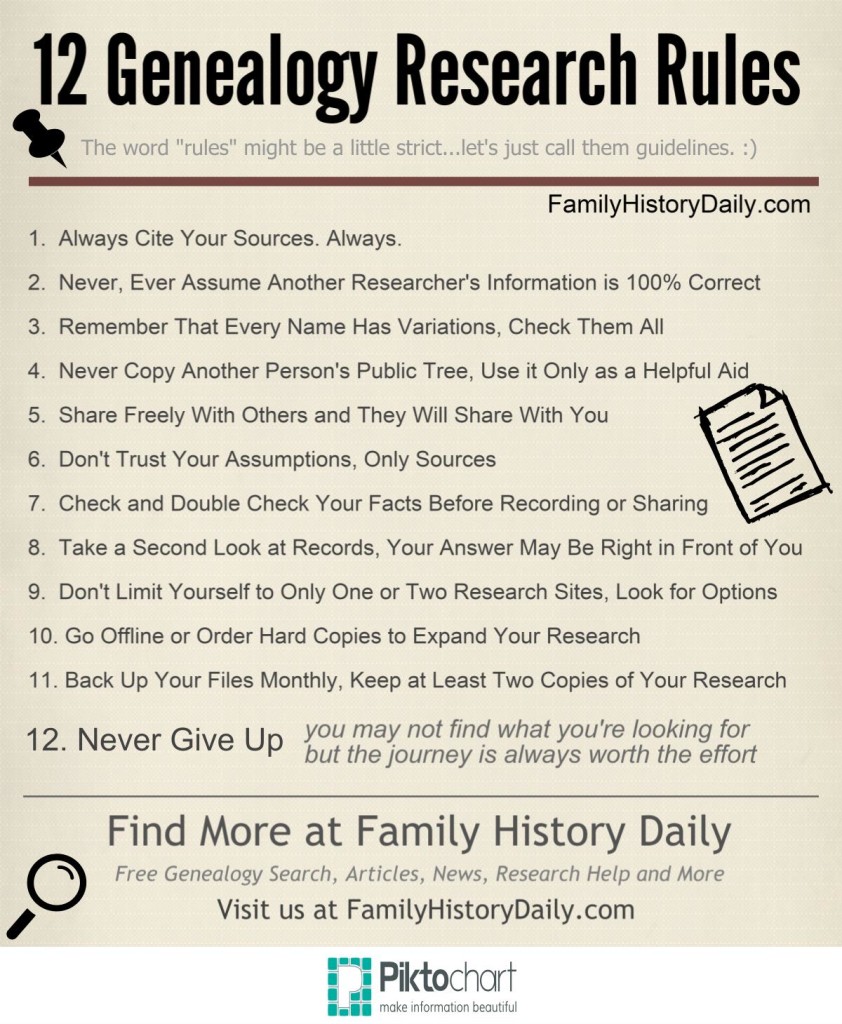Well, rules might be a bit strict, but we do have some pretty tight guidelines that we like to follow when we’re doing genealogy research. We promise we use them most of the time.
You likely have your own set of rules and we’d love to hear them. What would you add to this list?
Want to keep this list handy or share it with others? Download an infographic at the bottom of this page.
12 Genealogy Research Rules
1. Always Cite Your Sources. Always.
2. Never, Ever Assume Another Researcher’s Information is 100% Correct
3. Remember That Every Name Has Variations, Check Them All
4. Never Copy Another Person’s Public Tree, Use it Only as a Helpful Aid
5. Share Freely With Others and They Will Share With You
6. Don’t Trust Your Assumptions, Only Sources
7. Check and Double Check Your Facts Before Recording or Sharing
8. Take a Second Look at Records, Your Answer May Be Right in Front of You
9. Don’t Limit Yourself to Only One or Two Research Sites, Look for Options
10. Go Offline or Order Hard Copies to Expand Your Research
11. Back Up Your Files Monthly, Keep at Least Two Copies of Your Research
12. Never Give Up: you may not find what you’re looking for but the journey is always worth the effort
Image: Preparation for point rationing. 1943. Library of Congress


How do you handle adoptions in the descendants. I mean adoptions from unrelated families.
Lateral relatives (sisters, brothers, aunts, uncles, cousins, etc.) will almost always lead to break-throughs in your direct line, if you accumulate enough information and wait long enough, so don’t skip over them in your research – especially the childless ones, who often cared for nieces and nephews and left detailed wills….
Agree with Debra Peters. Soc. Sec. Death Index has my mother’s birth month and year correct; however, the day is incorrect.
All you can do is give the birth date and if the program requires it, mark them as living. Nothing else to be done.
What is the proper way to list living persons? Thank you.
On the topic of not assuming another researcher’s information is correct, I would add that it is important to remember that census takers and indexers of official databases are also “researchers”. However, as they don’t have intimate familiarity with their subjects, they will frequently make serious errors in spelling or transcription. I cannot count the number of misspelled names of people or places I have seen in “official” documents like censuses and Ellis Island records/transcriptions. I try to report transcription errors whenever I see them.
I love the list of rules, especially #2 (never , ever assume another researcher’s information is 100% correct). I had a relative send me a tree about our grand father’s family. She had a different person for my gg grandfather than I did. She said she found the information on a genealogy website. I had previously gone to my nearby FHL and viewed the parish registers (and made copies of them). I then sent my findings to my relative. Plus, I always cite my sources. That is important if there are discrepancies in the information.
Great list! I will take it one step further – Always cite your sources and photocopy/scan them (if not from an electronic source). You never know when you might need to go back and review the relevant pages from a source again. And if it was a pain to get the first time, imagine how annoyed you will be while you await that interlibrary loan! I’ve found this one out the hard way… I also agree with the “never give up.” New sources are added to online databases every day and I recently found a Slovakian birth record for my great-grandfather that wasn’t available when I originally searched several years ago.
This info is Great thank you
do not dismiss family stories there is often some truth in them but you need to prove it either way.
Great rules!!
This comment is directed to Sandy Shafer Guest.
The Pennsylvania Dutch are not Dutch as in from the Netherlands/Hollad, they are German as in Deutschland. I had always thought Dutch meant from the Neathetlands/Holland and then I found an article on the subject. I was surprised but after reading it made sense.
NEVER trust one source. My great grandmother is listed as married to her husband’s brother. We tried to get it fixed but the museum wouldn’t do anything. I was very surprised as I have sent notes about mistakes to the provincial archives of Nova Scotia, New Brunswick and Newfoundland and the latter not even my family, and they at least put a note beside item stating what the problem might be with that item.
You can’t always trust sources. My mother’s death date is wrong on the US Social Security Death Index…..
Unable to get on site, .Gave the only e-mail address that i have ever had. And the only pass word. Very disappointed.
Thank you for allowing me to join Family History Daily. I am hoping to find ANY INFORMATION on my Dad’s side of the family. I am looking for information on FAMILY TREES that include CARL L. SHAFER / NELLIE M. EARNHART, PAUL E. SHAFER / IDA (née ?) SHAFER, OR Carl & Paul’s FATHER: CHARLES F. SHAFER / ESTELLA V. SENSENBAUGH.. ESTELLA was the daughter of JOSEPH SENSENBACH / ANNE SYBIL MILLER. MOST ALL OF MY SHAFER SIDE OF THE FAMILY IS DECEASED, so I REALLY NEED YOUR HELP!! All of the records that I have been able to find indicate that everyone was born in PENNSYLVANIA, with the exception of Joseph SENSENBACH, who was born in Germany. I was told my whole life that we were PENNSYLVANIA Dutch. AGAIN, ANY HELP WOULD BE APPRECIATED!! Thanks!!